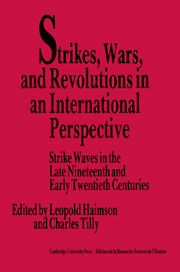 Strikes, Wars, and Revolutions in an International Perspective
Strikes, Wars, and Revolutions in an International Perspective Book contents
- Frontmatter
- Contents
- List of contributors
- Preface
- Part I Introductions
- Part II Models and realities
- 3 Introduction
- 4 Changing forms of labor conflict: secular development or strike waves?
- 5 Strikes and power in Britain, 1870–1920
- 6 Two strike waves in Imperial Russia, 1905–1907, 1912–1914
- 7 Strikers in revolution: Russia, 1917
- 8 Strikes in Imperial Russia, 1895–1913: a quantitative analysis
- 9 Labor conflicts in Italy before the rise of fascism, 1881–1923: a quantitative analysis
- 10 Strikes and politics in the United States, 1900–1919
- Part III Workers in metal-processing enterprises in comparative perspective
- Part IV The effects of short-term variation
- Part V Conclusion
10 - Strikes and politics in the United States, 1900–1919
Published online by Cambridge University Press: 25 March 2010
- Frontmatter
- Contents
- List of contributors
- Preface
- Part I Introductions
- Part II Models and realities
- 3 Introduction
- 4 Changing forms of labor conflict: secular development or strike waves?
- 5 Strikes and power in Britain, 1870–1920
- 6 Two strike waves in Imperial Russia, 1905–1907, 1912–1914
- 7 Strikers in revolution: Russia, 1917
- 8 Strikes in Imperial Russia, 1895–1913: a quantitative analysis
- 9 Labor conflicts in Italy before the rise of fascism, 1881–1923: a quantitative analysis
- 10 Strikes and politics in the United States, 1900–1919
- Part III Workers in metal-processing enterprises in comparative perspective
- Part IV The effects of short-term variation
- Part V Conclusion
Summary
The traditional view of the relationship between American trade unions and politics was that special factors in the American environment and in the attitude of American workers militated against the involvement of unions in politics and justified the pure-and-simple unionism of the American Federation of Labor. The view, associated with the historiography of John R. Commons and the “Wisconsin School,” has been subjected to considerable criticism in recent years. It has been pointed out that socialist influences within the unions were sometimes considerable (Laslett 1970), that at the level of the individual states labor political activity was significant (Fink 1973), and, more generally, that the teleological mode of presentation, whereby unions fulfilled their natural destinies and errors such as political involvement were rejected, was not the best way of understanding historical processes.
The outcome of these and other criticisms has been the emergence of a new approach in which political matters are given much more serious attention. Perhaps the largest claim for the importance of politics is that of Shorter and Tilly (1974, 329): until the 1930s “collective action was as much political as economic, intended equally to build political organization and press political demands and to elevate the standard of living by pressuring individual employers.” It will be convenient to use this statement as a starting point for the present discussion. The period 1900–19 is not chosen as a detailed case study; reasons of space preclude that. It is used simply as an illustration of some more general points about the relationship between strikes and politics.
- Type
- Chapter
- Information
- Strikes, Wars, and Revolutions in an International PerspectiveStrike Waves in the Late Nineteenth and Early Twentieth Centuries, pp. 247 - 258Publisher: Cambridge University PressPrint publication year: 1989
- 1
- Cited by


